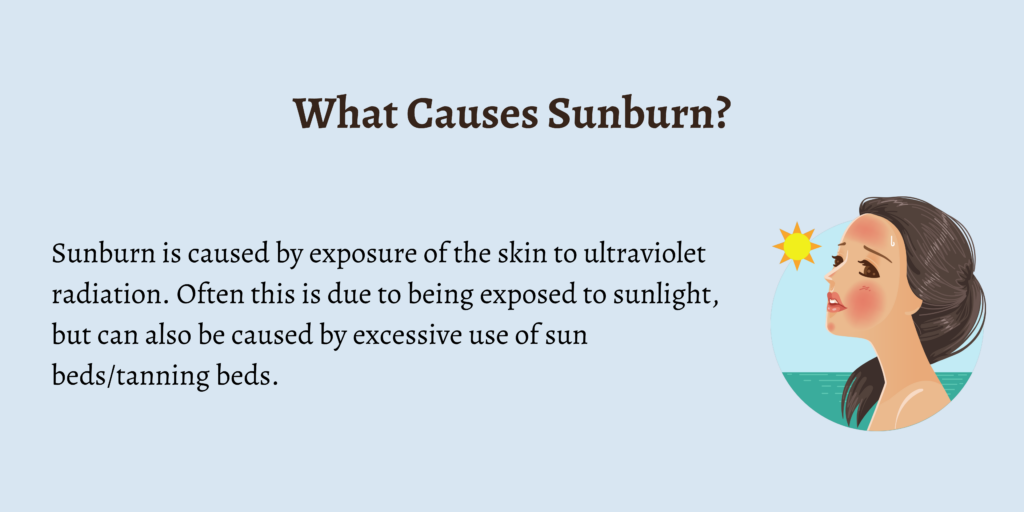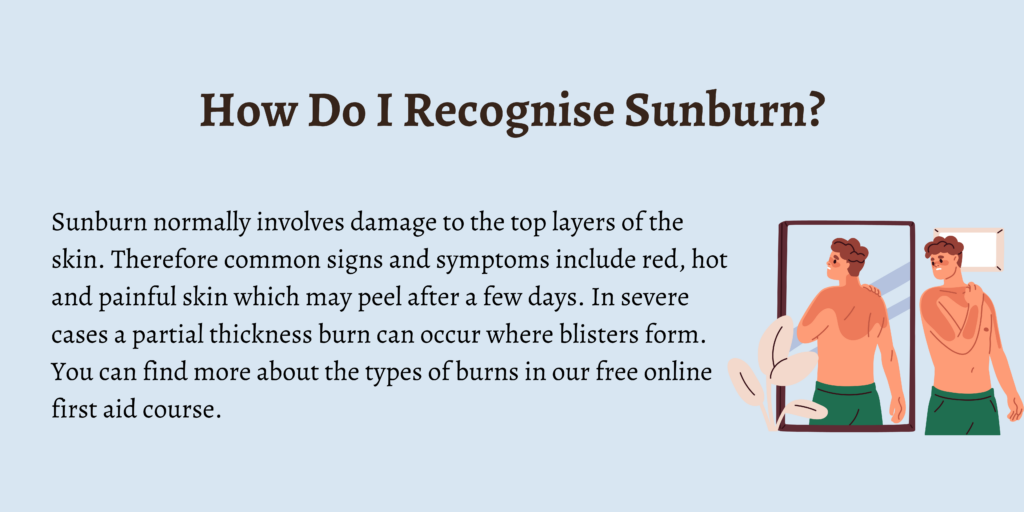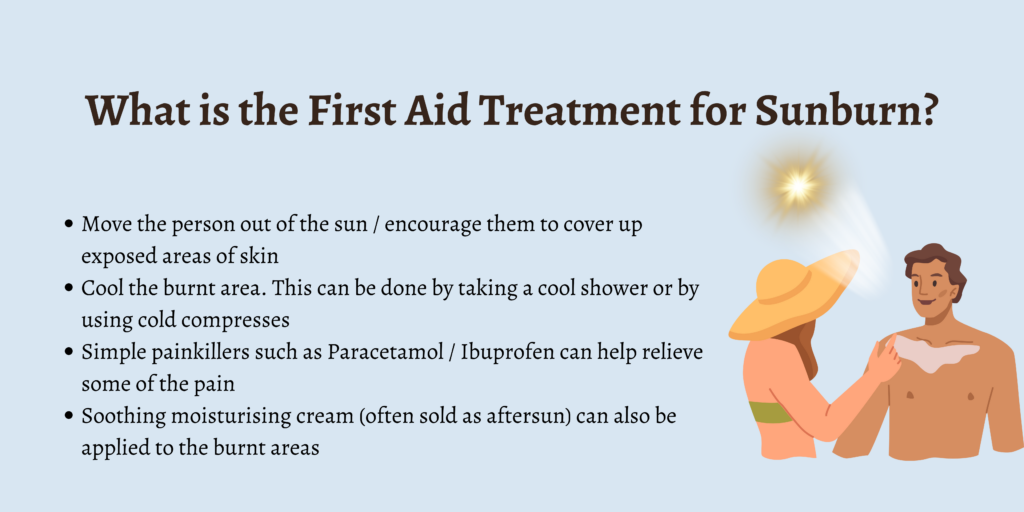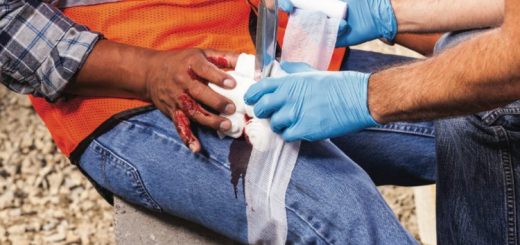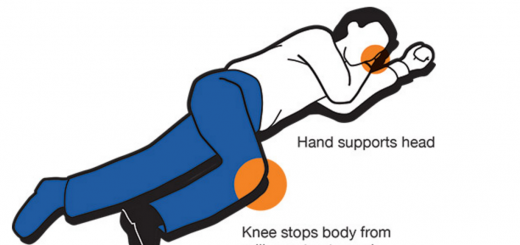First Aid for Sunburn
Sunburn is when your skin reacts after being exposed to ultraviolet or UV rays for a prolonged period. This can take place if you’re out in the sun or through tanning beds or sunlamps. The range of sunburn can vary from mild to severe.
Sunburns can lead to burning and pain, and studies also suggest that they can increase the risk of freckles, brown spots, wrinkles, and skin cancer.
However, sunburn doesn’t always happen by spending time at the pool or beach. It can also take place if you don’t wear sunscreen or while spending time outdoors through activities such as gardening or taking a walk.
Multiple sunburns can also cause premature skin aging. Therefore, it’s vital to be careful of sun exposure to reduce the risk of sunburn. In this article, we will be discussing how to prevent sunburn, what to do if someone gets sunburn, and more.
What Causes Sunburn?
Sunburn is caused by exposure of the skin to ultraviolet radiation. Often this is due to being exposed to sunlight, but can also be caused by excessive use of sun beds/tanning beds.
Everyone is at risk of sunburn, although the risk is higher for those with fair skin.
Severity of Sunburn
The severity of sunburn depends on the type of sunburn. The common types of sunburn are first-degree sunburns and second-degree sunburns.
First-Degree Sunburn
First-degree sunburn damages the outer layer of the skin and heals on its own, often within a couple of days. Some of the symptoms of first-degree sunburn are:
- Skin redness
- Soreness
- Blistering or swelling
- A tight or warm feeling
- Peeling skin
- Fatigue
- Headaches
- Nausea
- Raised temperature
Second-Degree Sunburn
Second-degree sunburn affects the outer layer of the skin and also the middle layer of the skin, which is known as dermis. It could take weeks for the skin to heal properly and could require to be treated by a specialist.
The symptoms of second-degree sunburn include:
- Pain
- Blistering or swelling over a big area
- Deep red skin
- Skin that displays white discoloration
- Skin that looks shiny and wet
People who experience second-degree sunburn should visit a doctor if their skin is severely swollen or blistered or if they experience symptoms of heat exhaustion or heat stroke. These symptoms are as follows:
- Exhaustion
- Nausea
- Confusion
- Slurred speech
- Feeling shivery and hot
- Muscle cramps
- Seizures
- Dizziness
- Rapid pulse or fast breathing
- Headache
- Having a high temperature
How Do I Recognise Sunburn?
Sunburn normally involves damage to the top layers of the skin. Therefore common signs and symptoms include red, hot and painful skin which may peel after a few days. In severe cases a partial thickness burn can occur where blisters form. You can find more about the types of burns in our free online first aid course.
What to Do if Someone Gets a Sunburn?
If someone gets a sunburn, take the following steps:
- Remove them from the sun immediately
- Place them in a shower or bath that’s cool but not cold
- Apply cold compresses on the burnt area multiple times a day. Don’t use harsh soap to wash skin that has been burned
- While aloe gel can be applied on the burnt region, stay away from lotions or creams as they could hold the heat inside the skin or contain numbing agents
- Make sure they stay well-hydrated for the upcoming two to three days
- Give the person medication such as acetaminophen or ibuprofen to soothe the pain, as directed by the doctor. Aspirin shouldn’t be given to children.
In order to prevent further sun exposure, ensure that all the areas that are sunburned are completely covered.
Call for immediate medical attention if the person displays the following symptoms:
- Clammy, pale, or cool skin
- Confusion
- Headache
- Feelings of dizziness
- Signs of skin infection
- Eyes that are light-sensitive or ones that hurt
- Severe chills, fever, or nausea
- Sunburn that is painful or leads to blisters
- Signs of dehydration
- Facial swelling
What is the First Aid Treatment for Sunburn?
- Move the person out of the sun / encourage them to cover up exposed areas of skin
- Cool the burnt area. This can be done by taking a cool shower or by using cold compresses
- Simple painkillers such as Paracetamol / Ibuprofen can help relieve some of the pain
- Soothing moisturising cream (often sold as aftersun) can also be applied to the burnt areas
If the burn looks severe, or there is evidence of blistering then professional medical help should be sought.
How to Prevent Sunburn
Here is how sunburn can be prevented:
- Avoid tanning beds and suntanning
- Try to stay away from sun exposure during the period when UV rays are at their strongest, which is usually between 10 am to 4 pm
- Wear a hat when you go out in the sun
- Protect yourself from UVA and UVB rays by making use of broad-spectrum sunscreen. Reapply it every 90 minutes while being outdoors and especially after sweating and swimming
- Visit a dermatologist on an annual basis to get checked for skin cancer
- Wear clothes that protect you from the sun, such as long-sleeved shirts, wide hats, and long pants
- Wear sunglasses that protect your eyes and help in filtering out the UV rays
- Whenever you’re outdoors, sit at spots that are shaded
- Be careful of sun exposure when consuming medicines that make your skin more sensitive
FAQs
1. How can sunburn be prevented?
Some of the ways in which sunburn can be prevented are by applying sunscreen, wearing protective clothing, and wearing a hat while being outdoors.
2. When should a person be given medical attention if they have sunburn?
A person should be given medical attention if they have sunburn when they display signs of dehydration, confusion, dizziness, or facial swelling.
3. What are the signs of first-degree sunburn?
The signs of first-degree sunburn are soreness, swelling, and redness.
4. What are the signs of second-degree sunburn?
The signs of second-degree sunburn are pain, blistering, swelling, and deep red skin.
5. Should sunscreen be reapplied for extra sun protection?
Yes, sunscreen should be reapplied every 90 minutes or two hours to keep yourself protected from UV rays.
Conclusion
Sunburns can happen quite easily and should definitely not be ignored. Following the necessary precautions is imperative to prevent sunburn, such as applying and reapplying sunscreen, wearing sunglasses, and going for protective clothing.
Not only are sunburns uncomfortable, but they also have long-term effects on your health and the appearance of your skin. They can also amplify the risk of a person developing skin cancer.
Therefore, going for periodic checkups is necessary to ensure that your skin is healthy and free from the risk of skin cancer.

